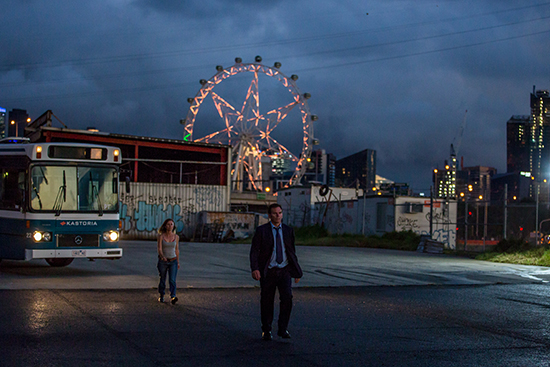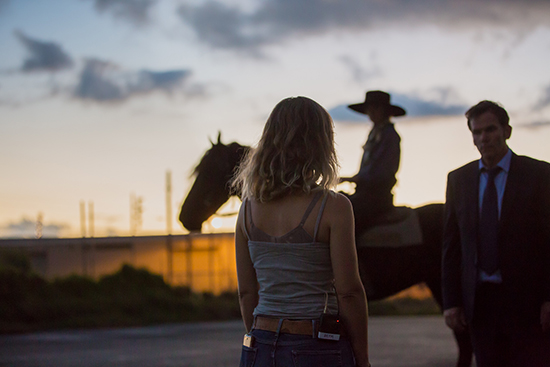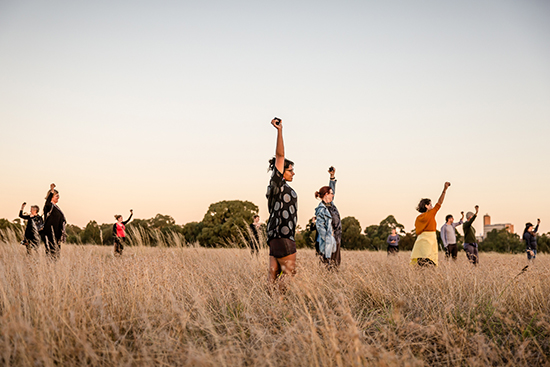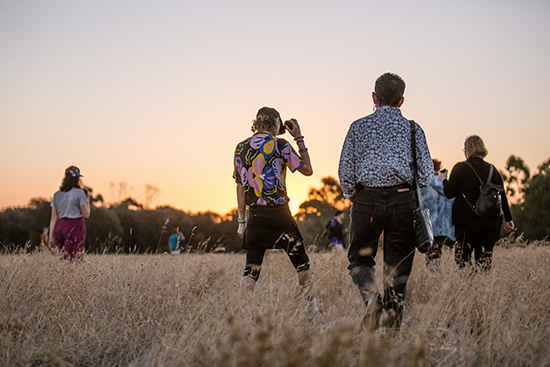The audience on the inside
John Bailey: Passenger; Aeon

Passenger
photo Gerard Assi
Passenger
It’s often claimed (wrongly) that the first film ever screened was the Lumiere Brothers’ Arrival of a Train at La Ciotat Station (1896). It’s often claimed (wrongly) that the first narrative film was the 1903 Western, The Great Train Robbery. And it’s often claimed (rightly) that trains and early cinema had a complex symbiotic relationship. The historian Wolfgang Schivelbusch in The Railway Journey (1979) has most thoroughly explored the way that the long-distance train journey opened up new experiences of the world as a panorama framed by the window, while cinema’s expansion of the optical unconscious is the subject of innumerable dissertations. Film transports us; the train window collapses time and space.
The makers of the recent Melbourne work Passenger are playing with and against this longstanding association. Though there’s not a camera or projector in sight, it’s closer to live cinema than theatre. The audience boards a bus rather than a train (though given the Western iconography that swirls around the work, it’s tempting to call it a stage coach). As the vehicle takes a leisurely tour around the city’s windswept West and market-driven Docklands, two passengers strike up a conversation and we’re party to their unfolding exchange.
Unless staring at the back of someone’s head is your thing, as you listen your gaze will inevitably be drawn to a window, where Melbourne’s cityscape plays backdrop to the ordinary dramas of the day and, occasionally, a cowgirl spurring her black steed into a trot or a grizzled farmhand with a shovel on some grim mission.

Passenger
photo Gerard Assi
Passenger
The Western is perhaps cinema’s most mythic of genres because its iconography is so cemented, its dramas so ritualised and its themes so familiar that even the slightest deviation from the usual is heralded as some daring triumph. Here the opposite is the case. While images redolent of the genre appear, for almost all of the journey they are barely glimpsed shadows, while the meandering conversation we’re listening to seems haphazard and awkward. The two strangers haltingly discuss job frustrations, Russian oligarchs, the murder of a homeless man, the price of milk. The text by Nicola Gunn has a very contemporary skittishness, while the performance plays out with the extreme laconicism of a Ranters Theatre work (one of the players, Beth Buchanan, is a key member of that company).
But such is the gravity of the Western genre that even anti-Westerns still end up as Westerns. While Passenger’s juxtaposition of striking cinematic visuals with underplayed and undramatic dialogue gives much of this production a jarring sense of disconnection, in its final minutes the action swells to match the Morricone-esque score that has intermittently risen on the bus speakers.
Everything that’s been said so far, it turns out, is tightly wound into a revenge scenario that ultimately takes the players out into the cinematic world on the other side of the window. Where most of the trip’s visuals thus far have been contingent on whatever is taking place on the street today, this final sequence fulfills the promise of cinema’s mise en scène, in which everything within the frame is under a filmmaker’s control. It’s a moment of minor magnificence at the end of a work in which the opposite had seemed the case.

Lz Dunn and local collaborators, AEON, Dance Massive 2017
photo Bryony Jackson
Lz Dunn and local collaborators, AEON, Dance Massive 2017
Lz Dunn’s Aeon is another peripatetic journey through the city with an even greater confidence that pays off richly. Audience members turn up to a secret location where they are equipped with a personal, hand-held speaker and sent off into nearby parkland at dusk. There are no performers, no-one to guide. The freedom is utterly unnerving, but quickly overrun by the equally startling sense of animal group dynamics.
Some members of the crowd wander off but never too far, while the mass itself seems to follow an instinct larger than any of its members. The sounds emanating from our hands often evoke bird calls (Dunn’s earlier iterations of similar work have drawn more directly on the study of bird flocking patterns), but here she has stripped away most literal references to flight in favour of producing an experience that’s nothing less than human murmuration.
It’s vital that there is no spoken component to the experience, and indeed that there’s little literal explanation of what’s going on. At the core of Aeon is a non-verbal experience of the animal aspects of human community, and with that comes a growing attunement to the details of the bushland in the fading light.
Later, non-avian visitors to this park are referenced as runners hurtle by and partially clothed bodies gyrate under bushes. The work ends with a blind dive into Lawrence English’s overwhelming soundscape, which at times is deep and loud enough to deliver a full-body massage. Arriving back into the now-night, it feels like some kind of wordless rite has been enacted, an Orphic passage, an animal transformation. Something vast enough to merit the work’s title, at least, while to an outsider it might all just look like a walk in the park.

Lz Dunn and local collaborators, AEON, Dance Massive 2017
photo Bryony Jackson
Lz Dunn and local collaborators, AEON, Dance Massive 2017
Passenger, devisors Jessica Wilson, Ian Pidd, Nicola Gunn, text Nicola Gunn, directors Ian Pidd, Jessica Wilson, composition Tom Fitzgerald, conceptual & devising contributions Bec Reid, Jeff Blake, performers Beth Buchanan, Jim Russel, Neil Thomas, Jamie Crichton; Footscray Community Arts Centre and Arts Centre Melbourne, 23-26 March; Dance Massive, Aeon, concept, artistic leader Lz Dunn, sound Lawrence English, choreography Shian Law, dramaturgy Lara Thoms; Arts House, Melbourne, 17-19 March
RealTime issue #138 April-May 2017






